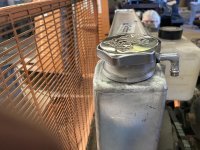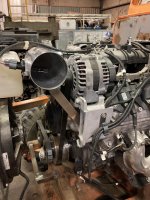Snowzilla work resumes. Actually, it resumed some time ago…
Both Thundercat and Snowzilla got upgraded with Eaton E-Lockers in their differentials. These aren’t cheap, but in certain situations having a selectable locking differential can be VERY handy. Neither Scott nor I have much experience installing these, so we did things the old-fashioned way…by the book. That means using a dial indicator, a micrometer, and an inch-pound torque wrench. VERY time consuming getting all the tolerances within Dana’s specifications, as well as the ring and pinion contact pattern. We removed the axle assemblies with the leaf springs attached and supported the axle housings on pipe stands so we could work on them comfortably standing up. We used the bridge crane in Scott’s shop as the E-locker carriers had to go in and out of the axle housings MULTIPLE times as various shim thicknesses were adjusted and tolerances checked. (The carrier can easily be lifted by hand, but using the crane really helps in preventing mashed fingers.) One can purchase special “set up bearings” which have been honed slightly so they can be installed and removed by hand as one adjusts the respective shim packs. After the final shim thicknesses are determined, new bearings are then pressed into position. Rather than purchase set up bearings, we used an old set of bearings and a die grinder with a small flapper wheel to remove some material and get the bearings to fit by hand. New bearings, seals and new pinion nuts were installed during final assembly. We’re slow, no doubt about it!
In the installation process we discovered some issues that had to be addressed. Snowzilla had a cracked spring perch, as well as a surprising amount of rust inside both axle housings. There was some other carnage as well. We surmise earlier in its life a pinion nut got loose allowing the pinion gear to contact the carrier. The ring and pinion gears were replaced, but the carrier still had the battle scars. Three of the four axle's differential covers showed “up close and personal” interactions with fixed objects. If you go off-road, or off-trail, with your snowcat, the snow can hide things just underneath the surface , and those things, such as rocks or stumps, can cause damage if you hit them. We decided some protection was wise, and all four axles got new differential covers made from 3/8" steel plate (purchased from Ruff Stuff Specialties). Many aftermarket differential covers are made from cast aluminum. They certainly look nice, and the aluminum does a better job of transferring heat from the gear lube, but if you run into a rock, that nice looking cover is likely to crack and if the differential fluid leaks out - you're done. Snowzilla’s spring eye “bushings” looked like heater hose and a local spring shop was unable to source new, correctly sized bushings. That meant new main leaves. But the process of forming the eyes in the individual spring leaves requires they use their furnace, which they only do when they can justify the expense. Translation…ten day delay…and that’s after the delay for the new special ordered bushings to arrive.
Pictures!
Snowzilla’s cracked spring perch.
 One of the mashed differential covers. (This was the worst and is (obviously) from Thundercat.)
One of the mashed differential covers. (This was the worst and is (obviously) from Thundercat.)

Note the street elbow installed in a Snowzilla diff cover by a previous owner. The concept is to raise the oil level inside the differential.
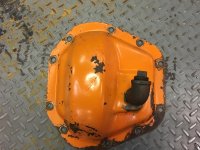
Scars on one of Snowzilla’s carriers.

Since we had the axles removed, we decided to copy a feature on the 1544. It has special spring U-bolt plates that have a tie-down loop incorporated and they make the process of securing a Tucker to a trailer a fair bit easier. We thought it was a clever design and Scott and I spent some time drawing it out on his CAD system (Scott did the drawing, I "helped"). Then we had a local vendor plasma cut them out of 1/2” steel plate before Scott added the bends with his hydraulic press. You might think the dimensions of the axle diameter and spring width were the same between the 1980 and 1986 machines, and thus we could merely copy the 1544’s plates. But you’d be wrong: both are different. We had enough made for both machines and got quotes from vendors for both plasma cutting and water jet cutting. Though the water jet process results in a nicer finished product, the cost was about double.
We erected a reusable, temporary paint booth and a mutual friend known as “The Evil Jester” painted a bunch of parts for us; first with a catalyzed epoxy primer and then he sprayed the top coat. They turned out surprisingly well, but there was a lot of work involved in prepping, hanging and masking all the individual parts. We believe if you’re going to go to all that work to take everything apart, it just doesn’t seem right to not continue the effort through the painting process, and that means using quality materials, too ($$$).
Some of the parts after primer was applied.
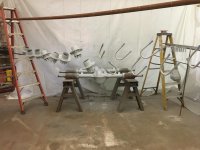
I had to include a pic of “The Evil Jester”. Believe me the name is appropriate; he is exceptionally quick witted…
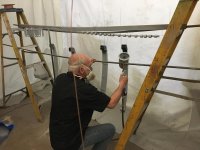
These are the tie-down/U-bolt plates I mentioned.

One of Snowzilla’s axles after painting and reassembly with new diff cover. Diff cover bolts are new stainless steel socket head cap screws with AN washers. Note the higher location of the fill plug.

After axle shaft installation. New Stover nuts and lock washers.

Unfortunately work, and progress, has come to a screeching halt. Summit County, Utah (where I live) issued a mandatory stay-at-home order, and that was followed up by both a voluntary state-wide order, and then another mandatory order in Salt Lake County, where Scott’s shop is.
My wife and I decided to “evacuate" to our second home in Southern Utah. There were (are) a number of maintenance projects we need to get done here so it seemed like the smart thing to do. BUT, it means no Snowzilla progress, and Scott and I have a LOT of work to do before Sun Valley 2021....
In the meantime I’m trying to think of parts that we will need, and ordering them so hopefully there will be fewer parts-related delays when the build resumes.
















